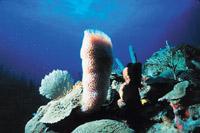Coral reefs

Florida's coral barrier is the largest in North America and the third in the world. The largest is Australia and the second is Brazil. All these reefs consist of communities of organisms that produce calcium carbonate. Coral reefs are underwater cities built over thousands of years with calcium carbonate.
Calcium carbonate is produced by many marine plants and animals, including some species of algae and marine invertebrates. Calcium carbonate is used as a skeleton, and the skeleton can be an internal skeleton similar to the human skeleton or an external skeleton similar to the snails. In both cases, calcium carbonate skeletons form rigid structures that support waves: reefs. When the main component of reefs are corals and some species of algae, reefs are called coral reefs.
In these coral reefs inhabit the colonies of small anemones. These organisms are often photosynthetic and although corals are carnivorous – they feed on zooplankton – most of the oxygen and energy they need to live are stored as side products of anemone photosynthesis. Anemones also increase calcium carbonate production in coral colonies, contributing to reef growth. The relationship between coral and anemone colonies is symbiotic, anemones are beneficial to corals and vice versa. Symbiotic relationships between organisms living in corals are very common.
Coral reefs are found in waters near dry land masses and require very precise physical conditions for their development. Coral barriers usually grow in tropical areas, between the tropics of Capricorn and Cancer, because tropical waters are warm, clear, with low levels of nutrients – nitrogen and phosphorous – stable levels of temperature and salinity. However, ocean currents can alter the physical state of an area and expand or reduce reef development regions. In Florida, for example, the hot waters of the Gulf Stream cause the coral barrier to grow further north than it would.
Reef rigidity is a natural barrier to protecting against the destructive power of tropical storms. Reefs are home to hundreds of marine beings: they are areas of great biodiversity, 22 of the 23 animal films on Earth. In turn, they are habitats with a high degree of carbon production, with 2,000 decagramos of carbon per square meter.
Buletina
Bidali zure helbide elektronikoa eta jaso asteroko buletina zure sarrera-ontzian











